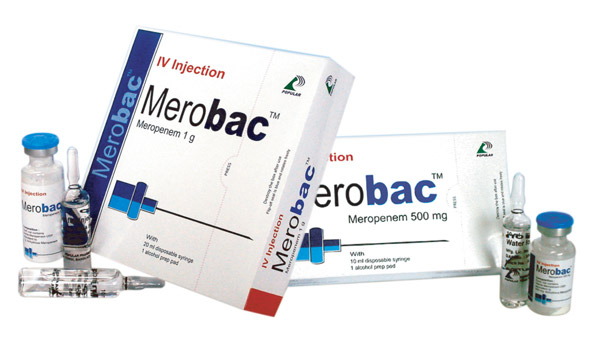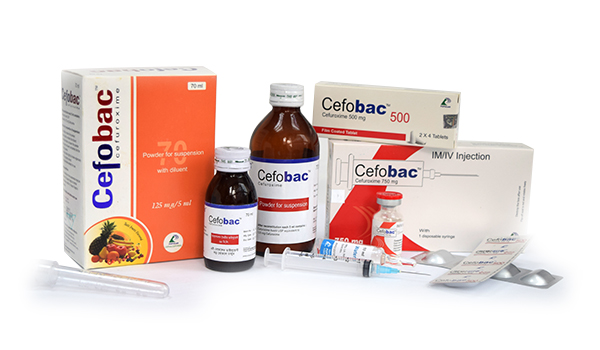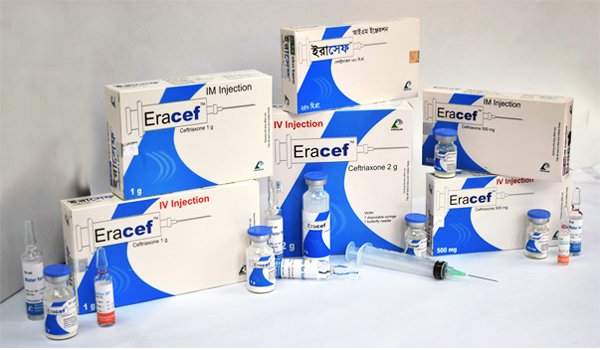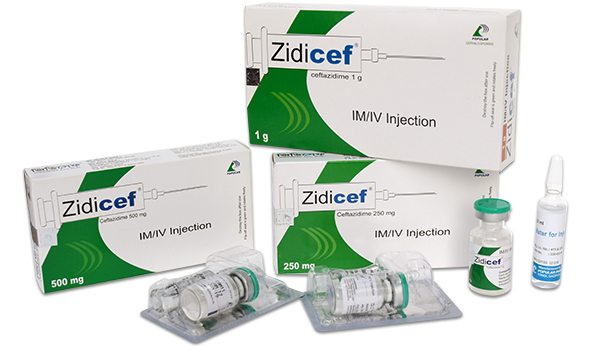Indication
The in vitro antibacterial spectrum of Meropenem includes the majority of clinically significant Gram-positive and Gram-negative, aerobic and anaerobic strains of bacteria. Meropenem is indicated for treatment in adults and children of the following infections caused by single or multiple susceptible bacteria and as empiric therapy prior to the identification of the causative organisms: Lower Respiratory Tract Infections including pneumonias and nosocomial pneumonias, Urinary Tract Infections including complicated infections, Intra-abdominal Infections, Gynaecological Infections including postpartum infections, endometritis and pelvic inflammatory disease, Skin and Skin Structure Infections, Meningitis, Septicaemia, Empiric treatment including initial monotherapy for presumed bacterial infections in host-compromised, neutropenic patients. Because of its broad spectrum of bactericidal activity against Gram-positive and Gram-negative aerobic and anaerobic bacteria Meropenem is effective for the treatment of polymicrobial infections.
Dosage & Administration
A) Adults: The dosage and duration of therapy shall be established depending on type and severity of infection and the condition of the patient. The recommended daily dosage is as follows: In the treatment of pneumonia, UTI, gynaecological infections such as endometritis,
skin and skin structure infections- 500 mg IV every 8 hours. In the treatment of nosocomial pneumonias, peritonitis, presumed infections in neutropenic patients, septicaemia- 1 g IV every 8 hours. In cystic fibrosis- doses up to 2 g every 8 hours. In meningitis- 2 g every 8
hours.
Exceptions: 1. Febrile episodes in neutropenic patients - the dose should be 1 g every 8 hours. 2. Meningitis - the dose should be 2 g every 8 hours. As with other antibiotics caution may be required in using Meropenem as monotherapy in critically ill patients with known or suspected Pseudomonas aeruginosa lower respiratory tract infections. Regular sensitivity testing is recommended when treating Pseudomonas aeruginosa infections. Meropenem should be given as an intravenous bolus injection over approximately 5 minutes or by
intravenous infusion over approximately 15 to 30 minutes. Dosage Schedule for Adults with Impaired Renal Function: Dosage should be reduced in patients with creatinine clearance less than 51 mL/min, as scheduled below:
|
Creatinine Clearance (mL/min) |
|
Dose (based on unit doses of 500 mg, 1 g, 2 g every 8 hours) | Frequency | |
|
26 to 50 10 to 25 <10 |
|
one unit dose one-half unit dose one-half unit dose |
|
every 12 hours every 12 hours every 14 hours |
Use in Adults with Hepatic Insufficiency: No dosage adjustment is necessary in patients with impaired hepatic metabolism.
B) Elderly:
No dosage adjustment is required for the elderly with normal renal function or creatinine clearance values above 50 mL/min.
C) Children:
For infants and children under 3 months: The efficacy and safety for infants and children under 3 months have not been established, therefore not recommended for such group of patients. For infants and children over 3 months and up to 12 years of age: The
recommended intravenous dose is 10 to 40 mg/kg every 8 hours depending on type and severity of infection, the known or suspected susceptibility of the pathogen(s) and the condition of the patient. In children over 50 kg weight, adult dosage should be used. 4 years
to 18 years with cystic fibrosis: 25 to 40 mg/kg every 8 hours.
Exceptions: 1. Febrile episodes in neutropenic patients - the dose should be 20 mg/kg every 8 hours. 2. Meningitis the dose should be 40 mg/kg every 8 hours. Meropenem should be given as an IV bolus over approximately 5 minutes or by intravenous infusion over approximately 15 to 30 minutes. There is no experience in children with renal impairment.
Direction of Reconstitution
The content of one vial is to be dissolved in 10 ml Water for injection for Merobac 500 mg IV injection and in 20 ml Water for injection for Merobac 1 g IV injection. As the product dissolves, carbon dioxide is released and a positive pressure develops. For ease of use the
following techniques of reconstitution are recommended.
Precautions
As with all beta-lactam antibiotics, rare hypersensitivity reactions have been reported. Before initiating therapy with Meropenem, careful inquiry should be made concerning previous hypersensitivity reactions to beta-lactam antibiotics. If an allergic reaction to Meropenem
occurs, the drug should be discontinued and appropriate measures should be taken. Use in infections caused by Methicillin resistant staphylococci is not recommended. The co-administration of Meropenem with potentially nephrotoxic drugs should be considered
with caution. Rarely, pseudomembranous colitis has been reported with Meropenem as with virtually all antibiotics; therefore, its diagnosis should be considered in patients who develop diarrhoea in association with the use of Meropenem. Use in children: Efficacy and tolerability
in infants under 3 months old have not been established; therefore, Meropenem is not recommended for use below this age. Use in patients with liver disease: Patients with pre-existing liver disorders should have liver function monitored during treatment with
Meropenem. Use in pregnancy: The safety of Meropenem in human pregnancy has not been established, although animal studies have not shown an adverse effect on the developing foetus. Meropenem should not be used in pregnancy unless the potential benefit
justifies the potential risk to the foetus. Use in lactation: Meropenem is detectable at very low concentrations in animal breast milk. Meropenem should not be used in breast-feeding women unless the potential benefit justifies the potential risk to the baby.







